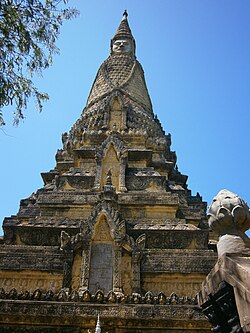Oudong - Kampong Speu
|
Udong ឧដុង្គ |
|
|---|---|
| — Town — | |
| Stupa of King Sisowath Monivong | |
|
|
|
| Coordinates: 11°48′N 104°45′E | |
| Country |
|
| Province | Kampong Speu Province |
| District | Udong |
| Time zone | Cambodia (UTC+7) |
Udong Khmer: ឧដុង្គ(also romanised as Oudong, U-Tong and Odong) is a town in Cambodia, situated in the north-western part of Kampong Speu Province. The town is located at the foothill of the mountain Phnom Udong, about 40 km northwest of the capital Phnom Penh. The temples are located on the mountain, which runs from the southeast to northeast, with a low saddle in the middle. Udong is a monumental necropolis of royalty for the past kings of Cambodia.
The city's name is derived from the Sanskrit word "uttuṅga" (Sanskrit: उत्तुङ्ग), meaning "supreme."[citation needed]
History
From 1618 until 1866 it was formally called "Udong Meanchey", home to a succession of kings, deposed from the former capital of Lovek by the invading Thais. In 1866, it was abandoned by King Norodom, taking his royal court along with him to the current capital, Phnom Penh. It was extensively damaged by the Khmer Rouge in 1977.
Folklore
Legend has it that in the Arthross Temple (Temple of Eight Points), the Buddha located here faces north instead of the traditional direction of east, symbolizing a testimony to the strength and power of the ancient Khmer kingdom.
In the 18th century, locals say, a Chinese emperor sent his people out across Asia to identify potential threats. When they came to Oudong, they saw a mountain shaped like a naga, with a cavern on top of the Arthross end, and they observed the wealth and power of Khmer society. The Chinese told their emperor that the Khmers were already a powerful race, and should a naga appear through the cavern of Arthross, they would be strong enough to rule the world.
The Chinese emperor did not want this, nor did he want a war. Instead, he asked the Khmer king if he could build a temple above the cavern, with the Buddha's face towards China in order to protect his empire. This was named the Arthaross temple, which means "eighteen corners", because there are 18 points, or corners, built into the temple's structure.









.png)







